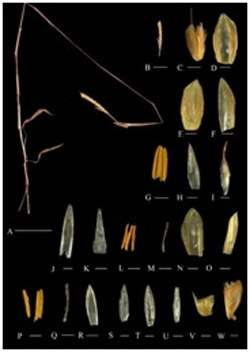 A new species of Indian Muraingrasses known for their ecological and economic importance, such as fodder, have been spotted by scientists in Goa in the Western Ghats, one of the four global biodiversity hotspots of India. The species has adapted to survive harsh conditions, low nutrient availability, and blossoms every monsoon.
A new species of Indian Muraingrasses known for their ecological and economic importance, such as fodder, have been spotted by scientists in Goa in the Western Ghats, one of the four global biodiversity hotspots of India. The species has adapted to survive harsh conditions, low nutrient availability, and blossoms every monsoon.
Globally 85 species are known from Ischaemum, of which 61 species are exclusively found in India. The Western Ghats have 40 species with the highest concentration of the genus.
Agharkar Research Institute (ARI), Pune, an autonomous institute of the Department of Science & Technology, has been exploring the biodiversity of the Western Ghats for last few decades.
A team led by Dr. Mandar Datar and Dr. Ritesh Kumar Choudhary from ARI has been working on relationships among different groups of plants and their evolutionary development (plant taxonomy and phylogeny) of Indian Muraingrasses (Genus Ischaemum) to document the diversity and report novel species. The team discovered a novel species named Ischaemum janarthanamii from plateaus of Western Ghats of Goa, and a research paper describing this species was published recently in Annales Botanici Fennici, a Finland based journal.
During their explorations on lateritic outcrops (habitats where portions of freely exposed bedrocks protrude above the soil level due to natural reasons) of Goa, the ARI team collected an interesting specimen of the species. Careful observations and critical morphological studies identified the species as a novel one. The species was named Ischaemum janarthanamii in honour of Prof. M. K. Janarthanam, Professor of Botany, Goa University, for his contribution to the Indian grass taxonomy and documentation of the floristic diversity of Goa state.
The first collection of this new species was made in the 2017 monsoon. The population was kept under observation for the next two years to confirm the consistency of its characters. Morphological and molecular data of the species were used to confirm the novelty of the species.
Ischaemum janarthanamii grows on low altitude lateritic plateaus in the outskirts of Bhagwan Mahavir National Park, Goa. The vegetation is exposed to extreme climatic conditions like desiccation in drier months and soils with low nutrient availability. However, withstanding these, the species has adapted to survive harsh conditions and blossom every monsoon.
Publication link:
https://doi.org/10.5735/085.057.0415
For further details, Dr. Mandar Datar (mndatar[at]aripune[dot]org, 020-25325057), Scientist, Biodiversity and Palaeobiology Group, and Dr. PK Dhakephalkar, Director (Officiating), ARI, Pune, (director[at]aripune[dot]org, 020-25325002) can be contacted.






























